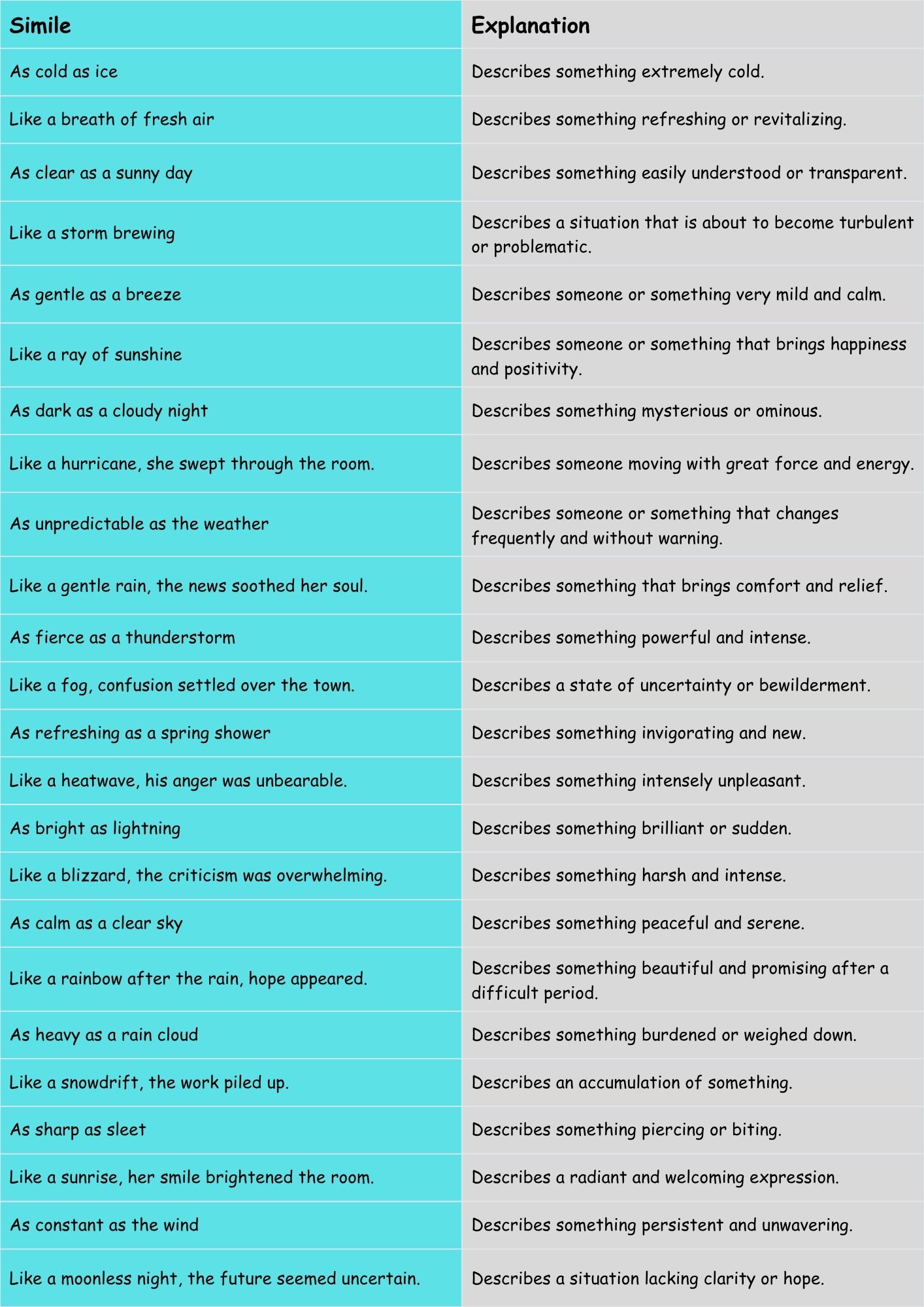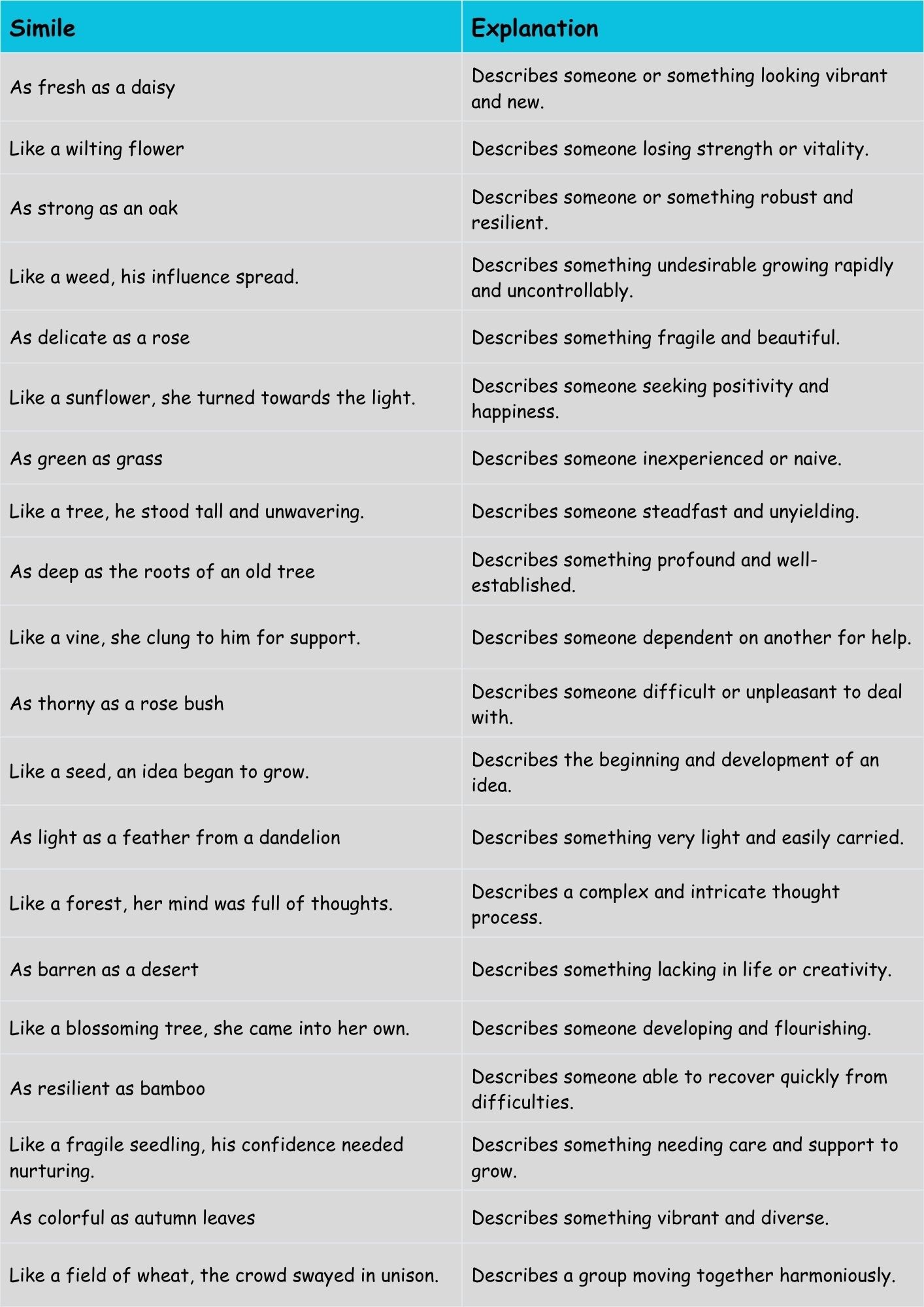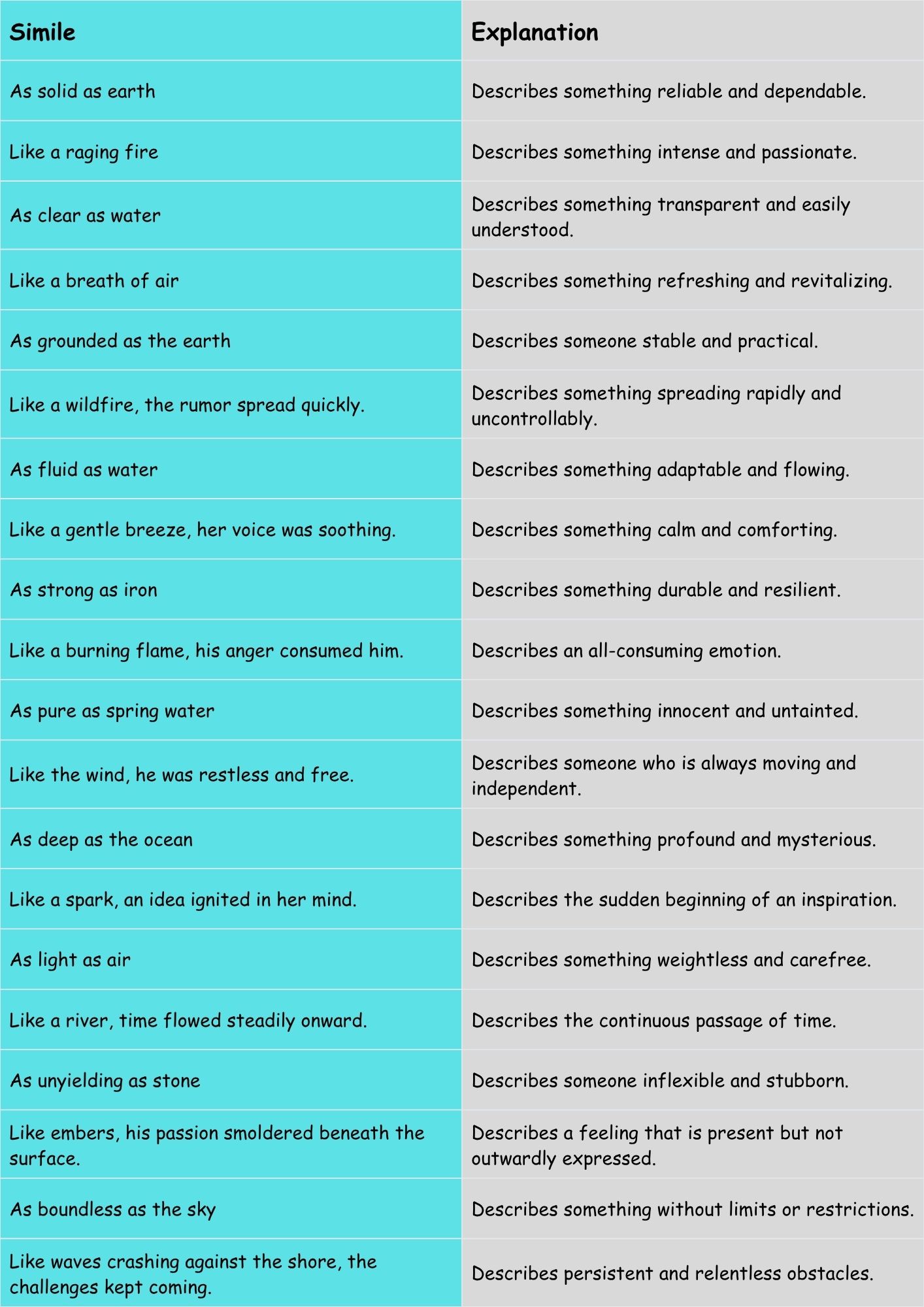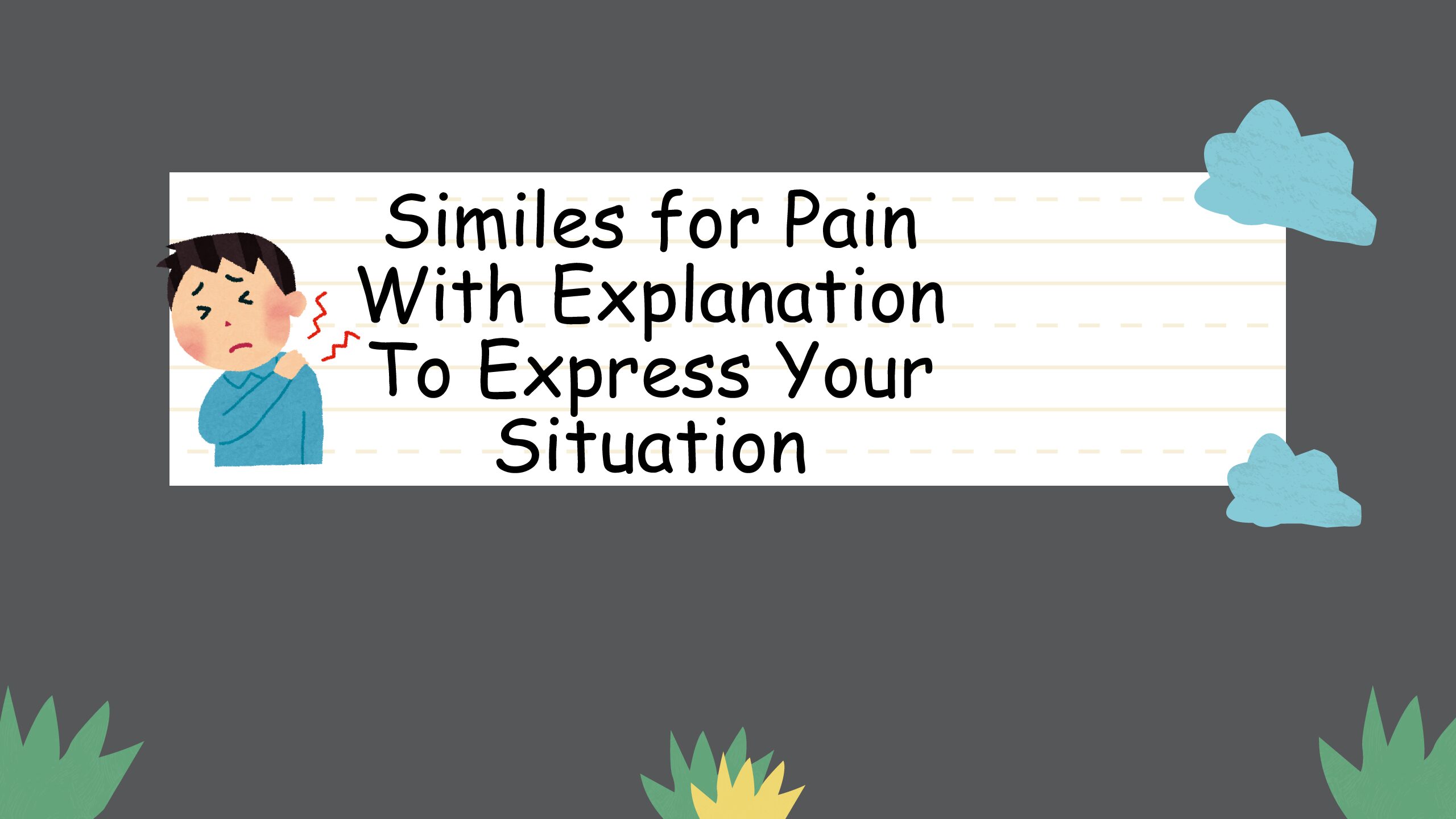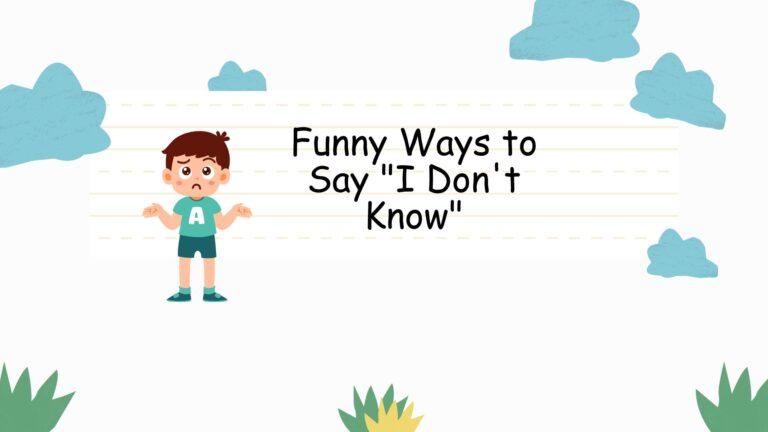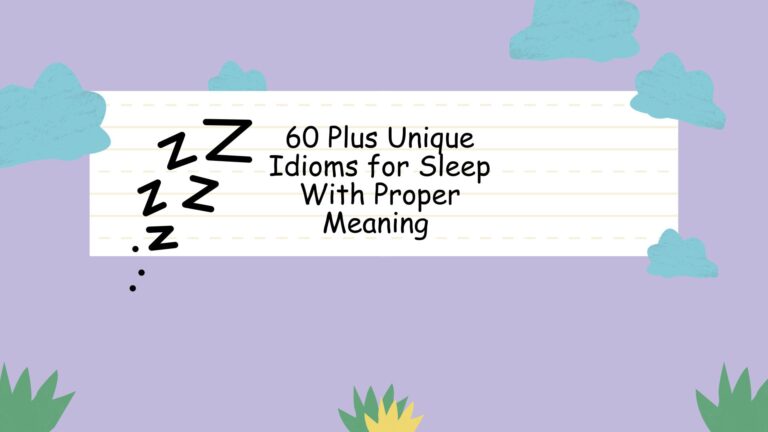
Nature’s Echo: Mastering Similes to Elevate Your English

Similes are powerful tools in the English language, allowing us to draw vivid comparisons and paint evocative pictures with our words. Understanding how to effectively use similes, particularly those related to nature, can significantly enhance your writing and communication skills. This article provides a comprehensive guide to mastering similes for nature, covering everything from basic definitions to advanced usage and common mistakes. Whether you’re a student, a writer, or simply someone looking to improve your command of English, this resource will equip you with the knowledge and practice you need to use similes with confidence and creativity.
Nature-based similes are particularly effective because they tap into universal experiences and imagery. By comparing something to a natural element, you can instantly create a relatable and impactful connection with your audience. This article will explore a wide range of nature-based similes, offering examples and exercises to help you integrate them seamlessly into your vocabulary and writing.
Table of Contents
- Definition of Simile
- Structural Breakdown of Similes
- Types of Nature Similes
- Examples of Nature Similes
- Usage Rules for Similes
- Common Mistakes with Similes
- Practice Exercises
- Advanced Topics in Similes
- Frequently Asked Questions (FAQ)
- Conclusion
Definition of Simile
A simile is a figure of speech that directly compares two different things, usually using the words “like” or “as.” The purpose of a simile is to highlight a shared quality or characteristic between the two items being compared, making the description more vivid and relatable. Similes are a fundamental part of figurative language, adding depth and color to both written and spoken communication. They help to engage the reader or listener by creating a mental image or association.
Unlike metaphors, which state that one thing *is* another, similes only suggest a similarity. For example, “He is a lion” is a metaphor, implying he possesses lion-like qualities such as bravery and strength. In contrast, “He is as brave as a lion” is a simile, explicitly comparing his bravery to that of a lion. This distinction is crucial in understanding the subtle yet important difference between these two figures of speech.
Structural Breakdown of Similes
The basic structure of a simile typically includes three key elements: the subject (the thing being described), the linking word (“like” or “as”), and the comparative element (the thing to which the subject is being compared). Understanding this structure allows you to construct effective and meaningful similes.
Here’s a breakdown of the components:
- Subject: The noun or pronoun that is being described.
- Linking Word: Usually “like” or “as,” connecting the subject to the comparative element.
- Comparative Element: The noun or phrase that the subject is being compared to.
Here are some examples illustrating the structure:
| Subject | Linking Word | Comparative Element | Simile |
|---|---|---|---|
| Her eyes | like | the deep blue sea | Her eyes are like the deep blue sea. |
| His voice | as | a roaring river | His voice was as a roaring river. |
| The snow | like | a white blanket | The snow fell like a white blanket. |
The power of a simile lies in choosing a comparative element that effectively conveys the intended meaning. The comparison should be clear, relevant, and ideally, evoke a specific image or emotion in the reader’s mind. By carefully selecting the subject, linking word, and comparative element, you can create similes that are both descriptive and impactful.
Types of Nature Similes
Nature similes draw comparisons between something and elements of the natural world. These can be categorized based on the specific aspect of nature being referenced. Here are some common types:
Weather Similes
Weather similes use weather phenomena to create comparisons. These can evoke specific moods and feelings associated with different weather conditions.
Animal Similes
Animal similes draw on the characteristics and behaviors of animals to describe people, objects, or situations. These similes can be particularly effective because animals often have well-defined associations.
Plant Similes
Plant similes use the qualities of plants, such as their growth, appearance, or fragility, to create comparisons. These can be used to describe beauty, resilience, or vulnerability.
Landscape Similes
Landscape similes use features of the natural landscape, such as mountains, rivers, or deserts, to create comparisons. These similes can evoke a sense of scale, grandeur, or desolation.
Elemental Similes
Elemental similes use the basic elements of nature, such as fire, water, earth, and air, to create comparisons. These similes can be very powerful, as these elements are often associated with fundamental aspects of life and existence.
Examples of Nature Similes
Here are some examples of nature similes, organized by category, to illustrate their diverse applications.
Weather Similes Examples
Weather similes often evoke emotions and sensations associated with different weather conditions. The following table provides a range of examples that showcase the versatility of weather-based comparisons.
| Simile | Explanation |
|---|---|
| As cold as ice | Describes something extremely cold. |
| Like a breath of fresh air | Describes something refreshing or revitalizing. |
| As clear as a sunny day | Describes something easily understood or transparent. |
| Like a storm brewing | Describes a situation that is about to become turbulent or problematic. |
| As gentle as a breeze | Describes someone or something very mild and calm. |
| Like a ray of sunshine | Describes someone or something that brings happiness and positivity. |
| As dark as a cloudy night | Describes something mysterious or ominous. |
| Like a hurricane, she swept through the room. | Describes someone moving with great force and energy. |
| As unpredictable as the weather | Describes someone or something that changes frequently and without warning. |
| Like a gentle rain, the news soothed her soul. | Describes something that brings comfort and relief. |
| As fierce as a thunderstorm | Describes something powerful and intense. |
| Like a fog, confusion settled over the town. | Describes a state of uncertainty or bewilderment. |
| As refreshing as a spring shower | Describes something invigorating and new. |
| Like a heatwave, his anger was unbearable. | Describes something intensely unpleasant. |
| As bright as lightning | Describes something brilliant or sudden. |
| Like a blizzard, the criticism was overwhelming. | Describes something harsh and intense. |
| As calm as a clear sky | Describes something peaceful and serene. |
| Like a rainbow after the rain, hope appeared. | Describes something beautiful and promising after a difficult period. |
| As heavy as a rain cloud | Describes something burdened or weighed down. |
| Like a snowdrift, the work piled up. | Describes an accumulation of something. |
| As sharp as sleet | Describes something piercing or biting. |
| Like a sunrise, her smile brightened the room. | Describes a radiant and welcoming expression. |
| As constant as the wind | Describes something persistent and unwavering. |
| Like a moonless night, the future seemed uncertain. | Describes a situation lacking clarity or hope. |
Animal Similes Examples
Animal similes are used to describe qualities or behaviors by comparing them to those of animals. These comparisons can be very effective because animals often have strong and recognizable characteristics. The following table provides further examples.
| Simile | Explanation |
|---|---|
| As sly as a fox | Describes someone cunning and deceitful. |
| Like a fish out of water | Describes someone uncomfortable or out of place. |
| As busy as a bee | Describes someone very active and hardworking. |
| Like a lion, he roared with anger. | Describes someone expressing anger in a powerful way. |
| As gentle as a lamb | Describes someone mild and innocent. |
| Like an owl, he was wise and observant. | Describes someone possessing wisdom and keen observation skills. |
| As stubborn as a mule | Describes someone very resistant to change or persuasion. |
| Like a hawk, she watched intently. | Describes someone observing something with focused attention. |
| As graceful as a swan | Describes someone elegant and refined in their movements. |
| Like a bear, he was strong and protective. | Describes someone with great strength and a protective nature. |
| As free as a bird | Describes someone unconstrained and independent. |
| Like a snake, he slithered through the crowd. | Describes someone moving sneakily or unnoticed. |
| As quiet as a mouse | Describes someone very silent and unobtrusive. |
| Like a wolf in sheep’s clothing | Describes someone who appears harmless but is actually dangerous. |
| As quick as a rabbit | Describes someone very fast and agile. |
| Like a peacock, she flaunted her beauty. | Describes someone displaying their attractiveness ostentatiously. |
| As loyal as a dog | Describes someone very faithful and devoted. |
| Like a turtle, he moved slowly and deliberately. | Describes someone moving with a slow and steady pace. |
| As timid as a deer | Describes someone shy and easily frightened. |
| Like a chameleon, he adapted to every situation. | Describes someone who can easily change to fit different circumstances. |
| As fierce as a tiger | Describes someone aggressive and powerful. |
| Like a swarm of locusts, they descended on the food. | Describes a large group consuming something rapidly. |
| As playful as a kitten | Describes someone full of energy and fun. |
| Like a bee to honey, he was drawn to her. | Describes someone attracted to something desirable. |
Plant Similes Examples
Plant similes often evoke images of growth, beauty, and fragility. They can be used to describe people, emotions, or situations in a way that is both evocative and relatable. The following table offers a variety of plant-based similes.
| Simile | Explanation |
|---|---|
| As fresh as a daisy | Describes someone or something looking vibrant and new. |
| Like a wilting flower | Describes someone losing strength or vitality. |
| As strong as an oak | Describes someone or something robust and resilient. |
| Like a weed, his influence spread. | Describes something undesirable growing rapidly and uncontrollably. |
| As delicate as a rose | Describes something fragile and beautiful. |
| Like a sunflower, she turned towards the light. | Describes someone seeking positivity and happiness. |
| As green as grass | Describes someone inexperienced or naive. |
| Like a tree, he stood tall and unwavering. | Describes someone steadfast and unyielding. |
| As deep as the roots of an old tree | Describes something profound and well-established. |
| Like a vine, she clung to him for support. | Describes someone dependent on another for help. |
| As thorny as a rose bush | Describes someone difficult or unpleasant to deal with. |
| Like a seed, an idea began to grow. | Describes the beginning and development of an idea. |
| As light as a feather from a dandelion | Describes something very light and easily carried. |
| Like a forest, her mind was full of thoughts. | Describes a complex and intricate thought process. |
| As barren as a desert | Describes something lacking in life or creativity. |
| Like a blossoming tree, she came into her own. | Describes someone developing and flourishing. |
| As resilient as bamboo | Describes someone able to recover quickly from difficulties. |
| Like a fragile seedling, his confidence needed nurturing. | Describes something needing care and support to grow. |
| As colorful as autumn leaves | Describes something vibrant and diverse. |
| Like a field of wheat, the crowd swayed in unison. | Describes a group moving together harmoniously. |
Landscape Similes Examples
Landscape similes use natural features to create comparisons that evoke a sense of scale, grandeur, or isolation. They can be used to describe emotions, situations, or physical attributes. The following table details landscape-based similes.
| Simile | Explanation |
|---|---|
| As vast as the ocean | Describes something immense and limitless. |
| Like a mountain, he stood firm. | Describes someone unwavering and resolute. |
| As deep as a canyon | Describes something profound and unfathomable. |
| Like a desert, the room was empty and lifeless. | Describes a place devoid of activity or emotion. |
| As winding as a river | Describes something convoluted or indirect. |
| Like a valley, she felt low and depressed. | Describes a feeling of sadness or despair. |
| As rugged as a mountain range | Describes something tough and unyielding. |
| Like a forest, the city was dense and confusing. | Describes a place that is complex and overwhelming. |
| As still as a lake | Describes something calm and peaceful. |
| Like a volcano, his anger erupted. | Describes a sudden and violent outburst of anger. |
| As high as a mountain peak | Describes something lofty and ambitious. |
| Like a waterfall, tears streamed down her face. | Describes a copious flow of tears. |
| As barren as the moon’s surface | Describes something devoid of life or interest. |
| Like a maze, the streets were confusing and intricate. | Describes a place that is difficult to navigate. |
| As expansive as the sky | Describes something boundless and limitless. |
| Like a hidden cave, her heart held many secrets. | Describes someone with concealed emotions or thoughts. |
| As isolated as a remote island | Describes someone feeling alone and disconnected. |
| Like a rolling plain, life stretched out before them. | Describes a future that appears long and uneventful. |
| As unpredictable as a geyser | Describes something that erupts or changes suddenly. |
| Like a vast tundra, the project seemed endless. | Describes a task that appears daunting and never-ending. |
Elemental Similes Examples
Elemental similes use the basic elements of nature (earth, air, fire, and water) to create comparisons. These elements often carry strong symbolic meanings, making the similes particularly evocative. The following table provides multiple elemental similes.
| Simile | Explanation |
|---|---|
| As solid as earth | Describes something reliable and dependable. |
| Like a raging fire | Describes something intense and passionate. |
| As clear as water | Describes something transparent and easily understood. |
| Like a breath of air | Describes something refreshing and revitalizing. |
| As grounded as the earth | Describes someone stable and practical. |
| Like a wildfire, the rumor spread quickly. | Describes something spreading rapidly and uncontrollably. |
| As fluid as water | Describes something adaptable and flowing. |
| Like a gentle breeze, her voice was soothing. | Describes something calm and comforting. |
| As strong as iron | Describes something durable and resilient. |
| Like a burning flame, his anger consumed him. | Describes an all-consuming emotion. |
| As pure as spring water | Describes something innocent and untainted. |
| Like the wind, he was restless and free. | Describes someone who is always moving and independent. |
| As deep as the ocean | Describes something profound and mysterious. |
| Like a spark, an idea ignited in her mind. | Describes the sudden beginning of an inspiration. |
| As light as air | Describes something weightless and carefree. |
| Like a river, time flowed steadily onward. | Describes the continuous passage of time. |
| As unyielding as stone | Describes someone inflexible and stubborn. |
| Like embers, his passion smoldered beneath the surface. | Describes a feeling that is present but not outwardly expressed. |
| As boundless as the sky | Describes something without limits or restrictions. |
| Like waves crashing against the shore, the challenges kept coming. | Describes persistent and relentless obstacles. |
Usage Rules for Similes
Using similes effectively requires understanding certain rules to ensure clarity and impact. Here are some key guidelines:
- Ensure a Clear Comparison: The two things being compared should have a recognizable similarity. The comparison should make sense and be easily understood by the reader.
- Avoid Clichés: Overused similes, such as “as busy as a bee” or “as strong as an ox,” can weaken your writing. Strive for originality and creativity in your comparisons.
- Use Appropriate Tone: The simile should match the tone of your writing. A humorous simile might be inappropriate in a serious context.
- Maintain Consistency: Ensure that the simile fits logically within the surrounding text. The comparison should enhance, not distract from, the overall message.
- Be Specific: The more specific your comparison, the more vivid the image you create. Instead of saying “He was as fast as an animal,” consider “He was as quick as a cheetah.”
A well-crafted simile can add depth and richness to your writing, making it more engaging and memorable. By following these rules, you can use similes to enhance your communication and create powerful imagery.
Common Mistakes with Similes
Even experienced writers can make mistakes with similes. Recognizing these common errors can help you avoid them and improve your writing.
| Mistake | Incorrect Example | Correct Example | Explanation |
|---|---|---|---|
| Using a Metaphor Instead of a Simile | He is a lion. | He is as brave as a lion. | A metaphor states that something *is* something else, while a simile uses “like” or “as” to make a comparison. |
| Using a Cliché | She was as pretty as a picture. | She was as radiant as a sunrise. | Clichés are overused and lack originality. |
| Unclear Comparison | The car was like a thing. | The car was like a speeding bullet. | The comparison should be specific and create a clear image. |
| Inconsistent Tone | The funeral was as fun as a barrel of monkeys. | The funeral was as somber as a cloudy day. | The simile should match the tone of the writing. |
| Illogical Comparison | The book was as loud as a tree. | The book was as engaging as a thrilling adventure. | The comparison should be logical and make sense. |
By being aware of these common mistakes, you can refine your use of similes and ensure that your writing is clear, effective, and engaging.
Practice Exercises
These exercises will help you practice identifying, completing, and writing similes. Each exercise is designed to reinforce your understanding of the concepts covered in this article.
Exercise 1: Identifying Similes
Identify the similes in the following sentences.
| Question | Answer |
|---|---|
| 1. Her smile was as bright as the sun. | as bright as the sun |
| 2. The wind howled through the trees. | (No simile) |
| 3. He ran like a cheetah. | like a cheetah |
| 4. The city is a jungle. | (No simile – this is a metaphor) |
| 5. The snow fell like a soft blanket. | like a soft blanket |
| 6. His anger was a fire. | (No simile – this is a metaphor) |
| 7. She sings like an angel. | like an angel |
| 8. The rain was relentless. | (No simile) |
| 9. They fought like cats and dogs. | like cats and dogs |
| 10. The news hit him like a ton of bricks. | like a ton of bricks |
Exercise 2: Completing Similes
Complete the following similes with an appropriate comparison.
| Question | Answer |
|---|---|
| 1. As quiet as a __________. | As quiet as a mouse. |
| 2. Like a __________, he stood tall. | Like a tree, he stood tall. |
| 3. As cold as __________. | As cold as ice. |
| 4. Her eyes were like __________. | Her eyes were like the deep blue sea. |
| 5. As busy as a __________. | As busy as a bee. |
| 6. The road was as winding as a __________. | The road was as winding as a river. |
| 7. He was as stubborn as a __________. | He was as stubborn as a mule. |
| 8. The city was like a __________. | The city was like a maze. |
| 9. Her voice was as smooth as __________. | Her voice was as smooth as silk. |
| 10. The project seemed as endless as a __________. | The project seemed as endless as a desert. |
Exercise 3: Writing Similes
Write your own similes based on the following prompts. Try to use nature-related comparisons.
| Prompt | Example Answer |
|---|---|
| 1. Describe the feeling of being overwhelmed. | The feeling of being overwhelmed was like being caught in a hurricane. |
| 2. Describe someone who is very strong. | He was as strong as an oak tree, weathering any storm. |
| 3. Describe a beautiful sunset. | The sunset was like a painting, with colors as vibrant as a field of wildflowers. |
| 4. Describe a peaceful forest. | The forest was as peaceful as a still lake, reflecting the sky above. |
| 5. Describe someone who is very fast. | She was as quick as a hummingbird, darting from one task to another. |
| 6. Describe the feeling of hope after a difficult time. | Hope appeared like a rainbow after a storm, promising brighter days ahead. |
| 7. Describe a person who is very wise. | He was as wise as an old owl, observing the world with knowing eyes. |
| 8. Describe the sound of a waterfall. | The sound of the waterfall was like a roaring river, powerful and untamed. |
| 9. Describe a person who is very adaptable. | She was like a chameleon, adapting to every situation with ease. |
| 10. Describe the feeling of loneliness. | The feeling of loneliness was like being stranded on a desert island, isolated and alone. |
Advanced Topics in Similes
For advanced learners, exploring the nuances and subtleties of simile usage can further enhance their writing skills. This includes understanding how similes can be combined with other figures of speech, such as metaphors and personification, to create complex and layered descriptions. Experimenting with unconventional comparisons and crafting extended similes that develop over several sentences can also add depth and originality to your writing. Analyzing the use of similes in literature and poetry can provide valuable insights into how master writers employ this technique to create powerful imagery and convey complex emotions. Paying attention to the cultural and contextual implications of similes is also important, as certain comparisons may resonate differently with different audiences.
Furthermore, advanced learners can explore the use of similes in persuasive writing and rhetoric. Understanding how similes can be used to create emotional connections with the audience and to make abstract concepts more relatable can be a powerful tool in argumentation and persuasion. Studying the use of similes in speeches, advertisements, and political discourse can provide valuable insights into how this figure of speech can be used to influence and persuade.
Frequently Asked Questions (FAQ)
Here are some frequently asked questions about similes, along with detailed answers to help clarify any confusion.
- What is the difference between a simile and a metaphor?A simile compares two things using “like” or “as,” suggesting a similarity. A metaphor, on the other hand, states that one thing *is* another, implying a stronger, more direct relationship. For example, “He is as brave as a lion” is a simile, while “He is a lion” is a metaphor.
- Why are similes important in writing?Similes add vividness and clarity to writing by creating relatable comparisons. They help readers visualize and understand concepts more easily, making the writing more engaging and memorable. Effective similes can also evoke emotions and create a deeper connection with the audience.
- How can I avoid using clichés in my similes?To avoid clichés, strive for originality and creativity in your comparisons. Think outside the box and consider less common or unexpected associations. Instead of relying on overused phrases, try to create your own unique similes that reflect your personal style and perspective.
- Can a simile be too long or complex?Yes, a simile can be too long or complex if it becomes convoluted or distracting. The goal of a simile is to enhance clarity, not to confuse the reader. Keep your similes concise and focused, ensuring that the comparison is easily understood and relevant to the overall message.
- Is it okay to use similes in formal writing?While similes are more commonly used in creative writing, they can also be appropriate in formal writing if used judiciously. The key is to ensure that the simile is appropriate for the tone and audience of the writing. Avoid overly informal or whimsical comparisons in formal contexts.
- How do I choose the right comparison for a simile?Choose a comparison that is relevant, clear, and evocative. The two things being compared should have a recognizable similarity, and the comparison should create a vivid image or association in the reader’s mind. Consider the tone and context of your writing when selecting the most appropriate comparison.
- What role do similes play in poetry?Similes are a fundamental tool for poets, enabling them to create imagery, convey emotions, and establish connections between seemingly disparate elements. They enrich the poetic language, offering depth and layers of meaning that resonate with readers. Poets often use similes to explore abstract concepts, making them relatable and tangible through vivid comparisons.
- How can I improve my ability to write effective similes?Practice is key. Read widely and pay attention to how other writers use similes. Experiment with different comparisons and ask for feedback on your writing. The more you practice, the better you will become at crafting effective and memorable similes.
Conclusion
Mastering similes, especially those related to nature, is a valuable skill that can significantly enhance your English language proficiency. By understanding the definition, structure, and usage rules of similes, you can craft more vivid and engaging descriptions in your writing and speech. Remember to avoid clichés, ensure clear comparisons, and tailor your similes to the appropriate tone and context.
Continual practice is essential for improving your ability to use similes effectively. Experiment with different types of nature similes, explore advanced topics, and learn from common mistakes. By incorporating similes into your everyday communication, you can
significantly enrich your language skills and express yourself with greater creativity and precision.

